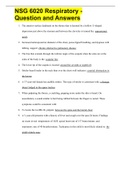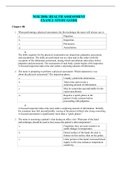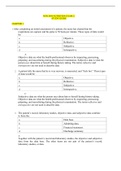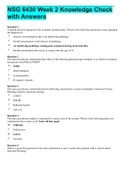Erickwhite
On this page, you find all documents, package deals, and flashcards offered by seller ERICKWHITE.
- 148
- 0
- 0
Community
- Followers
- Following
1 Reviews received
148 items

NSG 6020 Respiratory - Question and Answers
1. The anterior surface landmark on the thorax that is denoted by a hollow U-shaped depression just above the sternum and between the clavicles is termed the: suprasternal notch 2. Increased anteroposterior diameter of the chest, purse-lipped breathing, and dyspnea with talking, suggest: chronic obstructive pulmonary disease 3. The line that extends through the inferior angle of the scapula when the arms are at the sides of the body is the: scapular line 4. The lower tip of the scapula is loc...
- Exam (elaborations)
- • 6 pages •
1. The anterior surface landmark on the thorax that is denoted by a hollow U-shaped depression just above the sternum and between the clavicles is termed the: suprasternal notch 2. Increased anteroposterior diameter of the chest, purse-lipped breathing, and dyspnea with talking, suggest: chronic obstructive pulmonary disease 3. The line that extends through the inferior angle of the scapula when the arms are at the sides of the body is the: scapular line 4. The lower tip of the scapula is loc...

NUR 2058: HEALTH ASSESSMENT EXAM 2: STUDY GUIDE
1. When performing a physical assessment, the first technique the nurse will always use is: a. Palpation. b. Inspection. c. Percussion. d. Auscultation. B The skills requisite for the physical examination are inspection, palpation, percussion, and auscultation. The skills are performed one at a time and in this order (with the exception of the abdominal assessment, during which auscultation takes place before palpation and percussion). The assessment of each body system begins with inspect...
- Exam (elaborations)
- • 146 pages •
1. When performing a physical assessment, the first technique the nurse will always use is: a. Palpation. b. Inspection. c. Percussion. d. Auscultation. B The skills requisite for the physical examination are inspection, palpation, percussion, and auscultation. The skills are performed one at a time and in this order (with the exception of the abdominal assessment, during which auscultation takes place before palpation and percussion). The assessment of each body system begins with inspect...

NUR 2058 NUTRITION EXAM 2: STUDY GUIDE
1. After completing an initial assessment of a patient, the nurse has charted that his respirations are eupneic and his pulse is 58 beats per minute. These types of data would be: a. Objective. b. Reflective. c. Subjective. d. Introspective. A Objective data are what the health professional observes by inspecting, percussing, palpating, and auscultating during the physical examination. Subjective data is what the person says about him or herself during history taking. The terms reflective ...
- Exam (elaborations)
- • 116 pages •
1. After completing an initial assessment of a patient, the nurse has charted that his respirations are eupneic and his pulse is 58 beats per minute. These types of data would be: a. Objective. b. Reflective. c. Subjective. d. Introspective. A Objective data are what the health professional observes by inspecting, percussing, palpating, and auscultating during the physical examination. Subjective data is what the person says about him or herself during history taking. The terms reflective ...

NSG 6430 Week 2 Knowledge Check with Answers
Question 1 A patient has been diagnosed with secondary dysmenorrhea. Which of the following statements is true regarding the diagnosis?A Absence of menstruation due to an underlying pathology. Painful menstruation in the absence of pathology. An underlying pathology causing pain symptoms during menstrual flow. Painful menstruation that occurs in women after the age of 35. Question 2 The nurse practitioner understands that which of the following pharmacologic therapies is a...
- Exam (elaborations)
- • 2 pages •
Question 1 A patient has been diagnosed with secondary dysmenorrhea. Which of the following statements is true regarding the diagnosis?A Absence of menstruation due to an underlying pathology. Painful menstruation in the absence of pathology. An underlying pathology causing pain symptoms during menstrual flow. Painful menstruation that occurs in women after the age of 35. Question 2 The nurse practitioner understands that which of the following pharmacologic therapies is a...

NSG 6020 Week 5 Midterm Exam 2 with Answers
1. A patient tells the nurse that she has had abdominal pain for the past week. What would be the best response by the nurse? 1. “Can you point to where it hurts?” 2. “We’ll talk more about that later in the interview.” 3. “What have you had to eat in the last 24 hours?” 4. “Have you ever had any surgeries on your abdomen?” ANS: 1 A final summary of any symptom the person has should include, along with seven other critical characteristics, “Location: specific.” Ask ...
- Exam (elaborations)
- • 6 pages •
1. A patient tells the nurse that she has had abdominal pain for the past week. What would be the best response by the nurse? 1. “Can you point to where it hurts?” 2. “We’ll talk more about that later in the interview.” 3. “What have you had to eat in the last 24 hours?” 4. “Have you ever had any surgeries on your abdomen?” ANS: 1 A final summary of any symptom the person has should include, along with seven other critical characteristics, “Location: specific.” Ask ...

NSG 6020 Week 1 Quiz 1 with Answers
Question 1 When recording assessments during the construction of the problem-oriented medical record, the examiner should: Response Feedback: Once the examiner has a list of problems constructed, then an assessment is made for each unique problem. Question 2 What finding is unique to the documentation of a physical examination of an infant? Response Feedback: The size & characteristic of the fontanel are unique & important in the assessment of an infant. Data on l...
- Exam (elaborations)
- • 3 pages •
Question 1 When recording assessments during the construction of the problem-oriented medical record, the examiner should: Response Feedback: Once the examiner has a list of problems constructed, then an assessment is made for each unique problem. Question 2 What finding is unique to the documentation of a physical examination of an infant? Response Feedback: The size & characteristic of the fontanel are unique & important in the assessment of an infant. Data on l...

NSG 6020 Week 6 Quiz with Answers
A 42-year-old florist comes to your office, complaining of chronic constipation for the last six months. She has had no nausea, vomiting, or diarrhea, and no abdominal pain or cramping. She denies any recent illnesses or injuries. She denies any changes to her diet or exercise program. She is on no new medications. During the review of systems (ROS), you note that she has felt fatigued, had some weight gain, has irregular periods, and has cold intolerance. Her past medical history is significant...
- Exam (elaborations)
- • 10 pages •
A 42-year-old florist comes to your office, complaining of chronic constipation for the last six months. She has had no nausea, vomiting, or diarrhea, and no abdominal pain or cramping. She denies any recent illnesses or injuries. She denies any changes to her diet or exercise program. She is on no new medications. During the review of systems (ROS), you note that she has felt fatigued, had some weight gain, has irregular periods, and has cold intolerance. Her past medical history is significant...

NSG 6020 Week 3 Quiz with Answers
A condition associated with a chronic cough that produces copious amounts of purulent sputum is most likely: bronchiectasis When performing a respiratory assessment on a 4-year-old child, further evaluation is warranted in the presence of: supraclavicular retractions When percussing the chest in a patient who has left sided heart failure, the sound emanated would be: resonant Stridor heard louder in the neck than over the chest wall indicates: a partial obstruction in the larynx The middle s...
- Exam (elaborations)
- • 4 pages •
A condition associated with a chronic cough that produces copious amounts of purulent sputum is most likely: bronchiectasis When performing a respiratory assessment on a 4-year-old child, further evaluation is warranted in the presence of: supraclavicular retractions When percussing the chest in a patient who has left sided heart failure, the sound emanated would be: resonant Stridor heard louder in the neck than over the chest wall indicates: a partial obstruction in the larynx The middle s...

NSG 6020 Midterm Exam 1 with Answers
Question 1 (2 points) When preparing to perform a physical examination on an infant, the examiner should: Question 1 options: have the parent remove all clothing except the diaper on a boy. instruct the parent to feed the infant immediately before the exam. encourage the infant to suck on a pacifier during the abdominal exam. ask the parent to briefly leave the room when assessing the infant’s vital signs. Save Question 2 (2 points) A patient’s laboratory da...
- Exam (elaborations)
- • 52 pages •
Question 1 (2 points) When preparing to perform a physical examination on an infant, the examiner should: Question 1 options: have the parent remove all clothing except the diaper on a boy. instruct the parent to feed the infant immediately before the exam. encourage the infant to suck on a pacifier during the abdominal exam. ask the parent to briefly leave the room when assessing the infant’s vital signs. Save Question 2 (2 points) A patient’s laboratory da...

NSG 6020 Final Exam 1 with Answers
1. Question : You are beginning the examination of the skin on a 25-year-old teacher. You have previously elicited that she came to the office for evaluation of fatigue, weight gain, and hair loss. You strongly suspect that she has hypothyroidism. What is the expected moisture and texture of the skin of a patient with hypothyroidism? Student Answer: Moist and smooth Moist and rough Dry and smooth Dry and rough Points Received: 1 of 1 Comments: ...
- Exam (elaborations)
- • 35 pages •
1. Question : You are beginning the examination of the skin on a 25-year-old teacher. You have previously elicited that she came to the office for evaluation of fatigue, weight gain, and hair loss. You strongly suspect that she has hypothyroidism. What is the expected moisture and texture of the skin of a patient with hypothyroidism? Student Answer: Moist and smooth Moist and rough Dry and smooth Dry and rough Points Received: 1 of 1 Comments: ...

NSG 6020 WEEK 1 Quiz